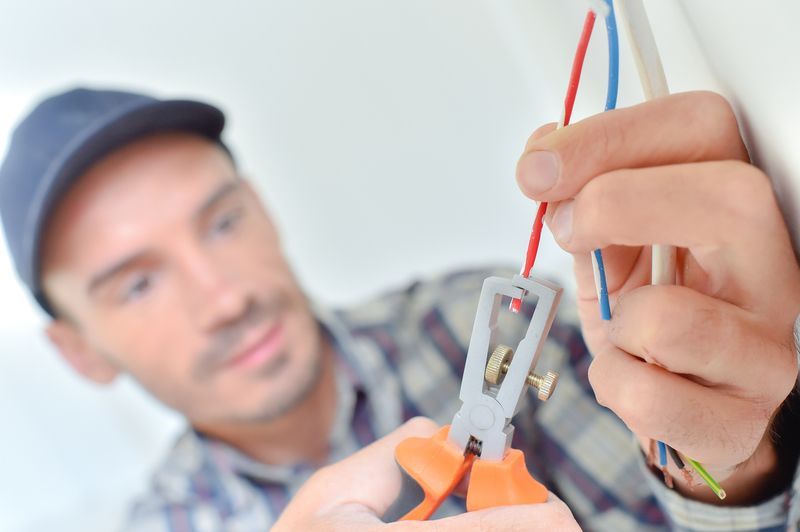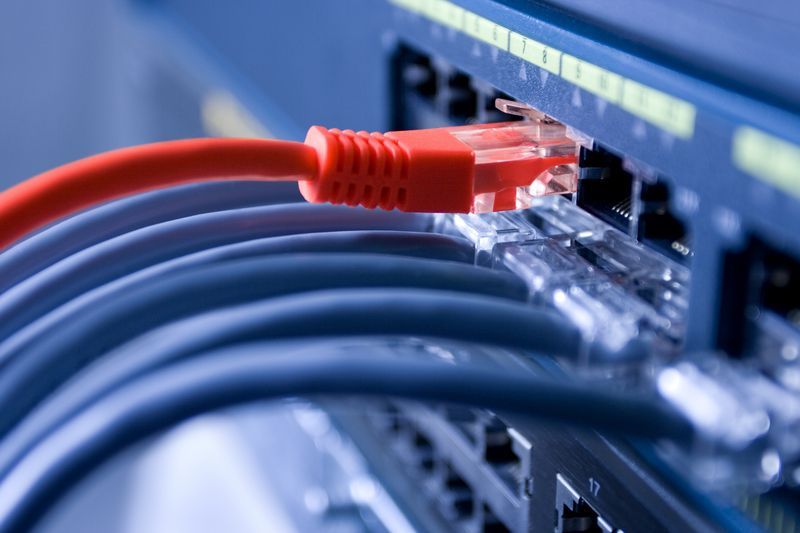Blog
Blog

November 5, 2024
Fiber optic technology stands out as a pivotal force driving the future of telecommunications and data transmission. As industries and consumers alike demand faster and more reliable connectivity, fiber optics have emerged as the gold standard, offering unprecedented speeds and efficiency.

October 5, 2024
In an era where the speed of data transmission and the ability to handle multiple high-demand applications simultaneously has become crucial, businesses are increasingly recognizing the need to upgrade their network infrastructure. High-speed networks are now essential to support the modern business ecosystem that includes cloud computing, high-definition video conferencing, real-time data analytics, and more. Upgrading the cabling infrastructure not only supports these evolving business needs but also enhances productivity and reduces latency, ensuring that businesses remain competitive in a digitally-driven marketplace.

September 19, 2024
The implementation of a network cabling system is crucial for any organization relying on robust IT infrastructure. This process spans initial design, installation, regular use, and eventual upgrades, all of which necessitate strategic planning and precise execution. Acknowledging and preparing for each phase of the cabling lifecycle not only enhances operational efficiency but also extends the system's longevity, ensuring organizations can adapt to evolving technological demands without compromising on performance.

September 5, 2024
In the ever-evolving landscape of information technology, the focus on sustainability within data infrastructure has become paramount. Green cabling introduces a meld of engineering innovation and environmental stewardship, offering compelling opportunities to enhance operational efficiency while significantly reducing ecological impacts. This discussion maps out the strategic approaches to integrating sustainability into cabling systems, from the selection of materials and cutting-edge technologies to optimized infrastructure design, all geared towards minimizing the carbon footprint of businesses and fostering healthier environments.

August 19, 2024
The world of network cabling is evolving rapidly, bringing new opportunities for faster and more reliable connectivity. Recent advancements are paving the way for improved data transmission and robust network infrastructure. These changes are essential for businesses and individuals who rely on strong and efficient connections for their daily operations. Understanding these developments can help you stay ahead in an increasingly connected world. The Evolution of Network Cabling: A Brief History Network cabling, a critical backbone of modern digital communication, has undergone significant evolution since its inception. The journey began with the deployment of simple telephone wires and has advanced to complex structured cabling systems that form the lifeline of today's internet and data communication. One of the major milestones in the history of network cabling was the introduction of coaxial cables in the 1940s, designed initially for television networks but later adopted for computer networks. The 1980s saw the emergence of twisted-pair cabling, which became the standard due to its cost-effectiveness and ability to reduce electromagnetic interference. Advancements continued with the development of fiber optic cables in the late 20th century, offering unprecedented speeds and bandwidth capacities. These innovations collectively contributed to the scalability and efficiency of network infrastructure, adapting to the demands of escalating data volumes and communication needs. The Current State of Network Cabling Today, network cabling is characterized by a variety of standards designed to meet the diverse requirements of different applications. The most widely used cabling standards include Category 5e (Cat5e), Category 6 (Cat6), and fiber optic cabling. Cat5e, Cat6A and Cat6, belonging to the twisted-pair cable family, are prevalent in most modern office environments, supporting Ethernet speeds up to 1 Gbps and 10 Gbps, respectively. Fiber optic technology, on the other hand, excels in high-speed data transmission over long distances, making it a preferred choice for backbone network connections and high-speed internet services. Structured cabling systems have become a cornerstone of modern infrastructure, integrating various data, voice, and video communications into a single, comprehensive network. This holistic approach ensures greater flexibility, scalability, and performance, accommodating the rapid advancements and increasing complexity of network environments. By adhering to standardized cabling and installation practices, businesses are better positioned to manage and expand their communication networks, facilitating seamless connectivity and operational efficiency. From its humble beginnings to the complex networks of today, network cabling has consistently evolved to support the relentless progress of technology. Understanding its history and current state is crucial for businesses looking to leverage connectivity to stay ahead in the digital age. Emerging Trends in Cable Technology The landscape of network cabling is continuously evolving, driven by technological innovations and the ever-increasing demand for faster, more efficient data transmission. Recent advancements in both copper and fiber-optic cables signify a leap toward unprecedented network performance and reliability. One of the most notable developments is the advent of Category 8 (Cat8) cabling. Designed to support bandwidths up to 2GHz (2000MHz) for up to 30 meters of cabling, Cat8 represents the future of copper cabling. Its introduction is specifically geared towards supporting high-speed data centers and applications requiring the utmost data transfer rates, like 25GBase-T and 40GBase-T ethernet connections. Parallelly, the adoption of fiber-optic technology continues to surge, majorly due to its superior bandwidth and durability benefits. Unlike traditional copper cables, fiber optics are less susceptible to electromagnetic interference and can transmit data over much longer distances without significant loss, making them ideal for the backbone of any extensive network system . The Demand for Speed and Bandwidth The relentless expansion of big data applications and the proliferation of the Internet of Things (IoT) devices have significantly raised the stakes for network infrastructure worldwide. These technologies demand not only higher speeds but also greater bandwidth to facilitate the seamless flow of massive volumes of data. The emergence of 5G technology is set to redefine network cabling requirements. While 5G is predominantly seen as a wireless technology, its backbone relies on a robust wired infrastructure to support the increased data rates and the density of the 5G network nodes. Consequently, both copper and fiber-optic cabling systems must evolve to accommodate these needs, ensuring minimal latency and maximum reliability . Smart Buildings and Integrated Systems The concept of intelligent building designs integrates network cabling into the very fabric of buildings, enabling automated and highly efficient management systems. In these smart buildings, network cabling plays a crucial role by providing the infrastructure needed to support a vast array of IoT devices and building management systems, including HVAC, lighting, security, and more. Intelligent cabling solutions, which are adaptable and can handle multiple types of data transmission, are becoming essential. These systems not only support the current needs of the building but also provide the scalability to adapt to future technologies and demands. The role of network cabling in this context is pivotal, as it ensures that smart buildings remain at the forefront of innovation, sustainability, and operational efficiency. As we push the boundaries of what's possible in network connectivity, the trends in cable technology, the increasing demands for speed and bandwidth, and the integration into smart buildings are shaping the future of connectivity. This evolution is not just keeping pace with technological advancement but is actively shaping the future of how we interact with and manage our digital world. I'm unable to fulfill this request. Unlock the potential of your network infrastructure with the latest advancements in cabling technology. Contact Data Cabling Service today to upgrade your network and stay ahead of the curve. Our experts are ready to transform your connectivity experience.

August 5, 2024
Selecting the right network cabling is crucial for an effective security system. The choice of cabling can impact the system's performance and reliability. By understanding the different types of cables and their benefits, anyone can make an informed decision. Proper cabling ensures that security cameras and other devices work seamlessly, providing the necessary protection and peace of mind. Overview of Advanced Security Systems In the realm of security, the advancements in technology have been significant, moving from analog systems to highly sophisticated digital solutions. This evolution has led to the integration of advanced security systems that rely extensively on network cabling. From high-definition (HD) cameras that offer unparalleled clarity to analytics tools capable of processing vast amounts of data for security insights, and real-time monitoring devices that ensure immediate response, the infrastructure supporting these technologies is crucial. The modern security landscape is populated with devices that are far more data-intensive than their predecessors. HD security cameras, for instance, provide detailed images that are essential for accurate identification and forensic analysis. The clarity comes at a cost of increased data size, necessitating robust network cabling solutions capable of handling the high bandwidth requirements. Similarly, analytics tools used in security systems process and analyze video feeds in real-time to detect anomalies or potential security breaches, relying on a seamless data flow that only high-quality cabling can ensure. Impact of High-Definition on Network Infrastructure The transition to high-definition security footag e is a double-edged sword. While it improves surveillance quality dramatically, it also places a significant strain on network infrastructure. HD video files are substantially larger and require more bandwidth for transmission and more storage space. This elevates the importance of selecting the right type of network cabling that can facilitate fast, secure, and reliable data transmission. Traditional Cat5e cables might fall short in supporting the data demands of HD surveillance, pushing organizations to consider more advanced options like Cat6 or fiber optic cables. Importance of Real-time Data for Security The need for real-time data in security systems cannot be overstated. The ability to monitor situations as they unfold enables security personnel to respond promptly, potentially averting crises. This immediacy demands an infrastructure that can manage the continuous flow of large volumes of data with minimal latency. The role of network cabling in this context is critical. It's not just about capacity but also the resilience and reliability of the cabling solution to ensure that data is not only transmitted quickly but also securely, without the risk of interception or loss. Addressing the challenges posed by these advanced security systems requires a strategic approach to network cabling. Understanding the specific needs of high-definition cameras, analytics tools, and real-time monitoring devices, and ensuring the network infrastructure is equipped to handle these demands, is essential for maintaining the efficacy and reliability of modern security systems. Cabling Requirements for High-End Security Systems As the complexity and sophistication of security systems increase, so does the importance of selecting the right type of network cabling to support them . High-end security systems require a robust infrastructure capable of handling not just the current data load but also future demands. Types of Cables Used in Security Systems In security systems, the choice between copper, fiber optic, and wireless solutions is dictated by several factors including distance, data rate requirements, and environmental conditions. Copper cables, like Cat6 and Cat6a, are typically used for shorter distances and offer the advantage of being cost-effective and easy to install. For higher data transmission speeds over longer distances, fiber optic cabling is preferred as it can support more bandwidth and is immune to electromagnetic interference. Wireless solutions, while offering the convenience of installation where cabling might be impractical, usually face limitations in terms of bandwidth and security vulnerabilities compared to wired connections. Bandwidth Considerations Calculating the required bandwidth for a security system involves understanding the data load from all connected devices, including cameras, sensors, and analytics tools. High-definition and 4K cameras, in particular, require more bandwidth for transmitting their video feeds. The role of network cabling in supporting these needs is crucial. Selecting a cable with insufficient bandwidth can lead to bottlenecks, reducing the system's efficiency and reliability. Ensuring Secure Data Transmission The integrity and security of data transmission are paramount in security systems to prevent breaches and unauthorized access. Implementing encryption within the network cabling infrastructure helps protect data in transit. Choosing secure cabling solutions and following best practices in network design can significantly reduce vulnerabilities. For instance, shielded twisted pair (STP) cables offer an added layer of protection against external interference and potential eavesdropping. Latency Issues and Solutions Latency in networked security systems can undermine the goal of real-time monitoring and swift response to security incidents. Factors that contribute to latency include the length of cabling, the type of cable used, and the network's overall architecture. Minimizing latency requires meticulous network design, opting for high-quality cables specifically suited for the distances and speeds required, and leveraging network switches and routers that can efficiently manage data traffic. The backbone of high-end security systems lies not just in the technologies deployed but in the capability of the network cabling infrastructure to effectively support these technologies. Understanding and addressing the cabling requirements can ensure that security systems are not only efficient and reliable but also scalable for future expansion. Best Practices and Recommendations for Advanced Security Systems Cabling Ensuring your advanced security system is built on a solid foundation requires careful planning and adherence to best practices. This final part of our series explores crucial recommendations for choosing and maintaining the right cables for your security system, future-proofing your network, and emphasizing the importance of professional installation. Choosing the Right Cables for Your Security System Selecting the right type of cable is the first step toward a reliable and efficient security system. Factors such as the distance between devices, bandwidth requirements, and environmental conditions play critical roles in this selection process. Copper vs. Fiber Optic For installations where high bandwidth and long distances are involved, fiber optic cables are preferable due to their superiority in speed and reliability over great lengths. Copper cabling, with options like Cat6 or Cat6a, can be sufficient for shorter distances and is more cost-effective for smaller systems. Environmental Considerations In environments where cables might be exposed to harsh conditions, it’s essential to select cables designed to withstand such environments. Outdoor or industrial-grade cables can offer added protection against moisture, temperature variations, and chemical exposure. Future-proofing Your Network for Scalability As security technologies evolve, your system’s infrastructure must be able to support new capabilities and higher data loads. Planning for future scalability involves: Over-Provisioning Bandwidth Installing cables that support higher bandwidth than currently needed can save significant time and expense in future upgrades. Modular Design Implementing a modular approach to network design allows for easier expansions or modifications as your security needs change. Professional Installation and Maintenance The complexity of advanced security systems makes professional installation and maintenance a necessity. Proper installation ensures that the system performs optimally from day one, while regular maintenance helps prevent potential issues before they arise. Certifications and Standards Ensuring that installation professionals adhere to industry standards and possess the necessary certifications can greatly impact the performance and reliability of your security system. Ongoing Maintenance Regular checks can help identify and rectify any emerging issues with the cabling infrastructure, preventing failures that could compromise security. The backbone of any advanced security system is its network cabling infrastructure. By understanding the various cabling options and considerations, you can ensure that your system is not only suited to your current needs but also equipped to handle future advancements. Choosing the right cables, planning for scalability, and insisting on professional installation and maintenance are all practices that set the stage for a robust, reliable security system. Remember, the effectiveness of your security measures is only as good as the network that supports it. Investing wisely in your cabling infrastructure is investing in the long-term security and safety of your premises. Ready to enhance your security system with the perfect network cabling? Contact Data Cabling Service today for expert advice and top-notch solutions. Let our team help you choose the best cabling options to ensure your security setup is reliable and efficient.

Our Licenses
Idaho - Contractor RCE-38750
Public Works PWC-C-10922-AA-4
Washington – Contractor #DATACCS781M7, Telecommunications
Nevada – Contractor 0073841, Class C-2D
California – Contractor 937948, Class C-7